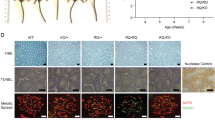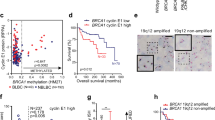Abstract
A biochemical approach was used to identify proteins which interact with human BRCA1. Through this work, a kinase activity which co-purifies with BRCA1 has been identified. This kinase activity, which phosphorylates BRCA1 in vitro, was originally identified in Sf9 insect cells but is also present in cells of human origin including breast and ovarian carcinoma cell lines. The BRCA1 kinase activity in vitro is associated with a fragment of BRCA1 encompassing amino acids 329–435. This peptide is also phosphorylated in various human cell lines. A computer-assisted sequence analysis revealed that this peptide was a potential substrate for phosphorylation by PKA, PKC, or CKII. However, phosphorylation by these kinases could not be demonstrated in vitro indicating the presence of another kinase activity. Phosphorylation in vitro requires a minimal domain of BRCA1 encompassing amino acids 379–408. Notably, deletion of this minimal domain abolishes growth suppression by BRCA1 indicating that this domain, as well as phosphorylation within this domain, may be important for BRCA1 function.
Similar content being viewed by others
Article PDF
Author information
Authors and Affiliations
Rights and permissions
About this article
Cite this article
Burke, T., Cocke, K., Lemke, S. et al. Identification of a BRCA1-associated kinase with potential biological relevance. Oncogene 16, 1031–1040 (1998). https://doi.org/10.1038/sj.onc.1201623
Received:
Revised:
Accepted:
Published:
Issue date:
DOI: https://doi.org/10.1038/sj.onc.1201623
Keywords
This article is cited by
-
Gene therapy for carcinoma of the breast: Therapeutic genetic correction strategies
Breast Cancer Research (1999)



